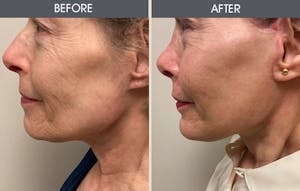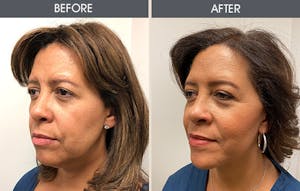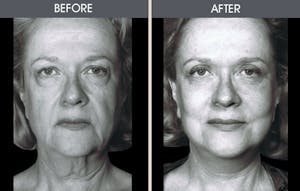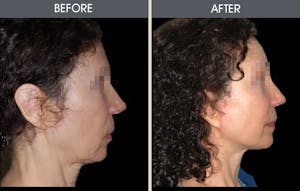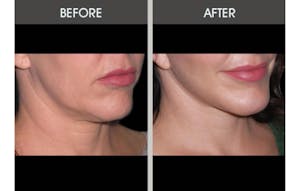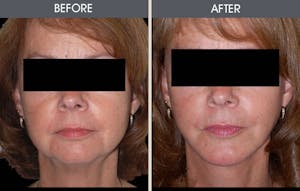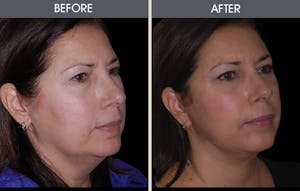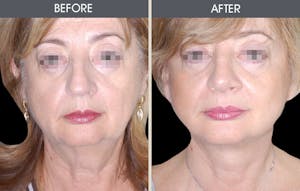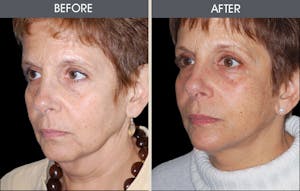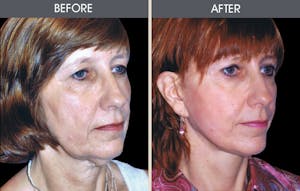Top New York plastic surgeon Dr. Darrick Antell is board-certified in plastic surgery, emphasizing aesthetic cosmetic surgery. One of the procedures he performs is the deep plane facelift in NYC, both full and regional.
A facelift, also known as a rhytidectomy, can improve the most visible signs of aging by the removal of excess fat, the tightening of underlying muscles, and the redraping of the skin of your face and neck. If you are considering a facelift, this page will give you an understanding of what to expect.

Considering Facelift Plastic Surgery
As people age, the effects of gravity, exposure to the sun and the elements, and the stresses of daily life can be seen on their faces. Deep creases form between the nose and mouth; the jawline grows slack and jowly; folds and fat deposits appear around the neck. A facelift (technically known as rhytidectomy) can't stop this aging process. What it can do is "set back the clock," improving the most visible signs of aging by removing excess fat, tightening underlying muscles, and redraping the skin of your face and neck. A facelift can be done alone, or it can be done in conjunction with other procedures such as a forehead lift, eyelid surgery, or nose reshaping.
If you're considering a facelift, the following information will give you a basic understanding of the procedure: When it can help, how it's performed, what type of facelift procedure (SMAS, deep plane, traditional, mini) is best for you, and what results you can expect. Because a lot depends on you as a patient—your goals, and what conditions you present with—it may not answer all of your questions or quell all of your concerns. Feel free to schedule a personal consultation with Dr. Antell for case-specific advice and answers to anything you don't understand.

The best candidates for a Facelift
The best candidate for a facelift is a man or woman whose face and neck have begun to sag, but whose skin still has some elasticity and whose bone structure is strong and well-defined. Most patients are in their 40s to 60s, but facelifts can be done successfully on people in their 70s or 80s as well.
A facelift can make you look younger and fresher, and it may enhance your self-confidence in the process. But it can't give you a completely different look, nor can it restore the health and vitality of your youth. Before you decide to have surgery, think carefully about your expectations and discuss them with your surgeon.
Planning your Facelift Plastic Surgery
Facelifts are very personalized procedures. In your initial consultation, Dr. Antell will evaluate your face, including the skin and underlying bone, and discuss your goals for the surgery. He will check for medical conditions that could cause problems during or after surgery, such as uncontrolled high blood pressure, blood clotting problems, or the tendency to form excessive scars. Be sure to mention if you smoke or are taking any drugs or medications, particularly aspirin or other drugs that affect clotting.
If you decide to have a facelift, your surgeon will explain the techniques and the method of anesthesia he will use, the type of facelift that he recommends specifically for your needs, such as a deep plane facelift, a mini facelift, or another type, the details about the facility where the surgery will be performed, and the risks and costs involved. Don't hesitate to ask any questions you may have, especially those regarding your expectations and concerns about the results.
Preparing for your Facelift Plastic Surgery
Dr. Antell will give you specific instructions on how to prepare for surgery, including guidelines on eating and drinking, smoking, and taking or avoiding certain vitamins and medications. Carefully following these instructions will help your surgery go more smoothly. If you smoke, it's especially important to stop at least a week or two before and after surgery; smoking inhibits blood flow to the skin, and can interfere with the healing of your incisions.
Whether your facelift is being done on an outpatient or inpatient basis, you should arrange for someone to drive you home after your surgery, and to help you out for a day or two if needed.
All Facelift Surgery carries some uncertainty and risk
When a facelift is performed by a qualified plastic surgeon, complications are infrequent and usually minor. Still, individuals vary greatly in their anatomy, their physical reactions, and their healing abilities, and the outcome is never completely predictable.
You can reduce your risks by closely following your surgeon's advice both before and after surgery.
Where your Facelift Surgery will be performed
A facelift may be performed in a surgeon's office-based facility, an outpatient surgery center, or a hospital. It's usually done on an outpatient basis, but some surgeons may hospitalize patients for a day when using general anesthesia. Certain conditions such as diabetes or high blood pressure should be monitored after surgery, and may also require a short inpatient stay. Dr. Antell does most of his surgeries in his state-of-the-art surgical facility in New York.
Types of anesthesia for a Facelift
Most facelifts are performed under local anesthesia, combined with a sedative to make you drowsy. You'll be awake but relaxed and your face will be insensitive to pain.
Some surgeons prefer general anesthesia. In that case, you'll sleep through the operation.
Short Scar Facelift
Short scar facelift surgery can be performed under local anesthesia or with sedation. This facelift is also known as the “ponytail-friendly procedure.” All facelifts are done under local anesthesia. In some cases, people prefer to have sedation. It can be mild, moderate, or heavier sedation. Rarely would it be done under general anesthesia unless there are other procedures being done at the same time that require that.
The Facelift Surgery
A facelift usually takes several hours, sometimes longer if you're having more than one procedure done. For extensive procedures, we may schedule two separate sessions.
Every surgeon approaches the procedure in his or her own way. Some complete one side of the face at a time, and others move back and forth between the sides. The exact placement of incisions and the sequence of events depend on your facial structure and the selected technique best suited to you. If the neck needs work, a small incision may also be made under the chin.
In general, whether the facelift is traditional, mini, deep plane, or SMAS, the surgeon typically separates the skin from the fat and muscle below. Fat may be trimmed or suctioned from around the neck and chin to improve the contour. The surgeon then gently repositions the underlying muscles and tightens the facial tissues. Stitches secure the layers of tissue and close the incisions; metal clips may be used on the scalp.
Following surgery, a small, thin tube may be temporarily placed under the skin behind your ear to drain any blood that might otherwise collect there. Your head may also be wrapped loosely in bandages to minimize bruising and swelling.
After your Facelift Surgery
There isn't usually significant discomfort after surgery; if there is, it can be lessened with the pain medication prescribed by your surgeon. (Severe or persistent pain or a sudden swelling of your face should be reported to Dr. Antell immediately.) Some numbness of the skin is quite normal; it will disappear usually in a few weeks.
Dr. Antell will have you keep your head elevated and as stationary as possible for a couple of days after surgery, to keep the swelling down. If you've had a drainage tube inserted, it will be removed 1 -2 days after surgery. Bandages, when used, are usually removed after 1 - 5 days. Don't be surprised at the pale, bruised, and puffy face you see—it is part of the healing process. Most of your stitches will be removed after about 1 week. Your scalp may take longer to heal, and the stitches or metal clips in your hairline could be left in a few days longer.

Facelift Before & Afters
Recovery after Facelift Surgery
You should be up and about in a day or two, but plan on taking it easy for the first week after surgery. Be especially gentle with your face and hair, since your skin will be both tender and numb, and may not respond normally at first.
Your surgeon will give more specific guidelines for gradually resuming your normal activities. They're likely to include these suggestions: Avoid strenuous activity including sex and heavy housework, for at least two weeks (walking and mild stretching are fine); avoid alcohol, steam baths, and saunas for several months. Above all, get plenty of rest and allow your body to spend its energy on healing.
Most patients are back at work about ten days to two weeks after surgery. Those having a mini facelift or a deep plane facelift in NYC generally may have a shorter recovery period. If you need it, special camouflage makeup can mask most bruising that remains.
Your new look after Facelift Surgery
Having a facelift doesn't stop the clock. Your face will continue to age with time, and you may want to repeat the procedure one or more times, perhaps 10 years down the line. So while you will continue to age, if you had an identical twin who did not have a lift, you would always look better than your twin.
What types of a Facelifts are available?
Commonly when only the term "face-lift" is used, the face and neck are what are being referred to. There are also mini lifts that are also called neck-only lifts, face-only lifts, deep face lifts, or regional facelifts, depending on the patient’s particular concern.
How long does a Facelift last?
No one can say for sure how long a facelift lasts. The clock is turned back, but does keep on running. Ten years later, you may look better than if you never had facelift plastic surgery. Different types of facelifts, such as the deep plane facelift, may last for a particularly long period of time. Many patients never have a second facelift, while others may desire further plastic surgery 7 to 15 years later.
Can a Facelift be done without scars?
The scars from facelift plastic surgery usually fade and are barely perceptible. In some patients, especially younger ones, endoscopic surgery can be used to lift the eyebrows, remove frown lines, elevate the cheek and jowls and tighten the neck. This endoscopic surgery can be done with tiny scars. However, if there is excessive skin, it must be removed for the best results through standard facelift incisions.
Procedure Spotlight - Deep Plane Facelift
Dr. Antell offers the Deep Plane Facelift procedure. This procedure refers to a specific type of facelift in which the SMAS is lifted to tighten the cheeks, jaw and neck.
The SMAS is a layer of connective tissue underlying the skin and top facial muscles. Addressing this during a deep plane facelift can have powerful results.
Because it focuses on the structural factors of a patient's face, it can have results that last up to 10 years, though results can vary from patient to patient. If you are interested in learning more about deep plane facelift surgery in Manhattan, please contact us to schedule a consultation with Dr. Antell.
What will be discussed during my consultation for a Facelift?
Dr. Antell will ask you what concerns you most about your appearance and address that region first and foremost. He will talk about your options, the facelift surgery and the deep plane facelift technique, the risks, and potential complications, your recovery period, how much downtime you should allow yourself, the operating room, and the anesthesia.
He will show you in a mirror how much improvement you can expect from facelift surgery by simulating the amount of tension with his hands. He believes that computer imaging gives false expectations as it does not take into account the texture, thickness, and elasticity of your skin, or your ability to heal.
Dr. Antell spends as much time as is necessary with you to make sure you fully understand all the aspects of the procedure. Dr. Antell has had cosmetic surgery himself and speaks from experience as a patient as well as a doctor.
Can I have other procedures of the face done at the same time as a Facelift?
Yes, very often patients have their eyes or their brow done at the same time. If the surgery is warranted, the final result is uniform and balanced and there is only one recovery period. Some patients ask that their nose be touched up, because as we age, the tip of the nose can start to sag as well.
Other patients find that they have lost volume in their lips as they've gotten older and request a fat transfer to bulk up their lips for a more youthful, pouty appearance.
What is the Submuscular Aponeurotic System?
The SMAS is a layer beneath the skin which invests the facial muscles. By tightening the SMAS, the jowls are lifted, the neck is tightened, and the cheeks are elevated. This type of facelift is called an SMAS or deep plane facelift and represents an improvement over earlier skin-only techniques.
How to get started?
Dr. Darrick E. Antell and his staff will be happy to discuss a facelift (or “rhytidectomy”) with you. Please call for a private consultation or schedule an appointment online at our office.











